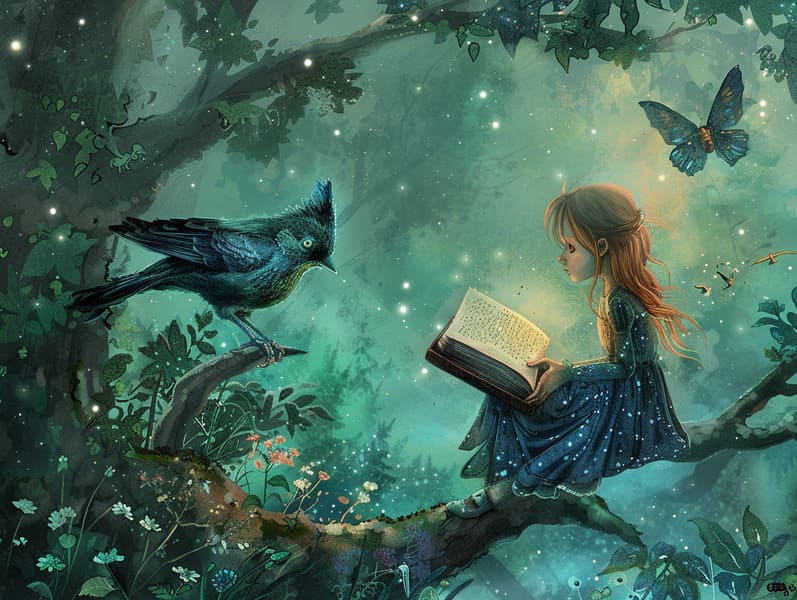The Story Behind Children's Fairy Tales with Its Unceasing Magic.

Timeless fairy tales have enduring presence. These stories have been recounted from one generation to the next long before they were ever inscribed. They sprang from a variety of civilizations, including Indigenous traditions. They were initially passed along among older generations, often carrying themes and messages reflective of the societal norms and beliefs of the time.
The Brothers Grimm, the two Grimm brothers, were among the first to gather many of these beloved fairy tales. Their published works, "Grimm's Fairy Tales," included classics like "The True Bride," "Little Brother and Little Sister," and "Snow-White and Rose-Red," which have since become classics in the world of classic fairy tales. Similarly, H. C. Andersen's imaginative tales, such as "The Story of the Little Mermaid," and "The Ugly Duckling," have captured hearts worldwide, establishing their place in the pantheon of famous fairy tales.
Though they are centuries old, fairy tales remain as applicable as ever, especially as bedtime stories for kids. These magical stories are now available in many formats, including vividly illustrated books, enchanting animations, and digital fairy tales.
Their continued relevance can be traced to several enchanting factors:
Ethical Lessons: Old fairy tales often convey important moral lessons. Stories like "The Story of the Boy Who Cried Wolf" teach the significance of honesty, while "The Tortoise and the Hare" emphasize the virtues of tenacity and meekness. These stories offer little ones clear distinctions between moral and immoral, forming their moral compass in a gentle yet impactful way.
Compassion and Insight: Ancient fairy tales frequently feature figures facing trials and tribulations, stimulating young listeners to resonate with their struggles and applaud their triumphs. For instance, "The Tale of Beauty and the Beast" shows us the importance of seeing inner beauty to see the inner being of a soul, encouraging tenderness and perception.
Cultural Comprehension: Many fairy tales are deeply embedded in the cultural contexts from which they came. Learning from these stories can provide captivating looks into different heritages, encouraging a sense of world appreciation and recognition.
Fantasy and Innovation: The fantastical elements in classic fairy tales—mythical creatures—enliven children’s imaginative ideas. These fairy tales transport readers to mythical realms, promoting imaginative dreams and a sense of amazement that stays a lifetime.
Ancient fairy tales are not only magical but also didactic. They function as mesmerizing tools in building various intellectual and emotional capacities in the young. When fairy tales are voiced, they cultivate linguistic abilities by offering new lexicon and complex sentence structures. This practice also boosts auditory skills and mindfulness, as young readers keep up with the story, excited to see what happens next.
Furthermore, contemplating the themes and characters of ancient fairy tales can nurture popular fairy tales with morals evaluative skills and analytical skills. Children are taught to discern patterns, forecast, and know cause and effect. These conversations also help the young reveal their thoughts and feelings, nurturing their emotional intelligence.
In today’s digital age, the prevalence of online fairy tales has made these stories more attainable than ever. Web platforms and applications offer broad selections of bedtime fairy tales that can be read or listened on anytime, anywhere. Fairy tales recited are particularly popular, offering an captivating way for the young to savor these enchanting tales. Audiobooks and read-aloud videos lead characters and settings to life, often paired with spellbinding audio effects and soundtracks that enhance the story adventure.
The lasting allure of old fairy tales lies in their ability to evolve to present eras while retaining their main lessons. Contemporary renditions of these stories often spotlight more varied figures and modern settings, making them familiar to today’s audience. However, the fundamental themes of fortitude, warmth, and rightness remain unchanged, continuing to reach readers of all ages.
Ancient fairy tales also offer a sense of coziness and homeliness. They make available a neat narrative with a unmistakable beginning, middle, and end, often drawing to a close with the settlement of conflicts and the triumph of virtue over corruption. This reliability can be relieving for the young, extending a sense of solidity in an unstable world.
Traditional fairy tales continue to mesmerize and coach new generations, maintaining their allure and significance in modern society. As children's bedtime stories, they deliver up a perfect blend of charm and understanding, nourishing moral values, empathy, and creativity. The abundance of online fairy tales and the commonness of fairy tales read out loud confirm that these timeless tales remain accessible to new generations.
By conserving and circulating these narratives, we continue to exalt the rich tapestry of legends and cultural heritage. Whether you are reading a gorgeously illustrated book, browsing a virtual library, or listening through an read-aloud story, the radiance of old fairy tales is always within reach. These tales demonstrate of the persistent ability of stories and its ability to join us across time and space.
Whether you are experiencing a richly illustrated book, perusing a virtual collection, or listening via an read-aloud story, the captivation of bedtime fairy tales is always within reach.
These narratives demonstrate of the enduring power of fairy tales and its ability to connect us across generations and cultures, forming a connection that fascinates and enlightens alike.